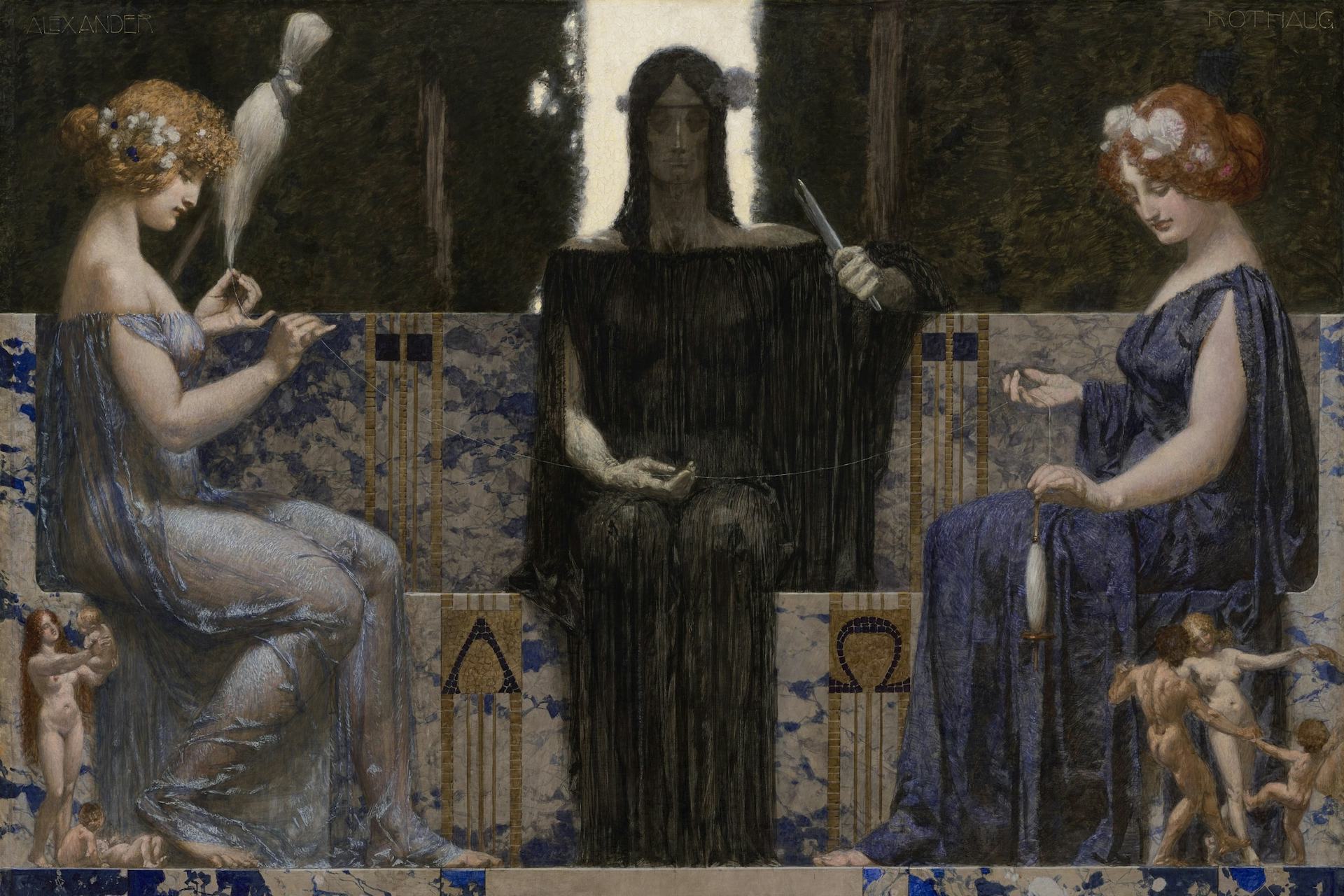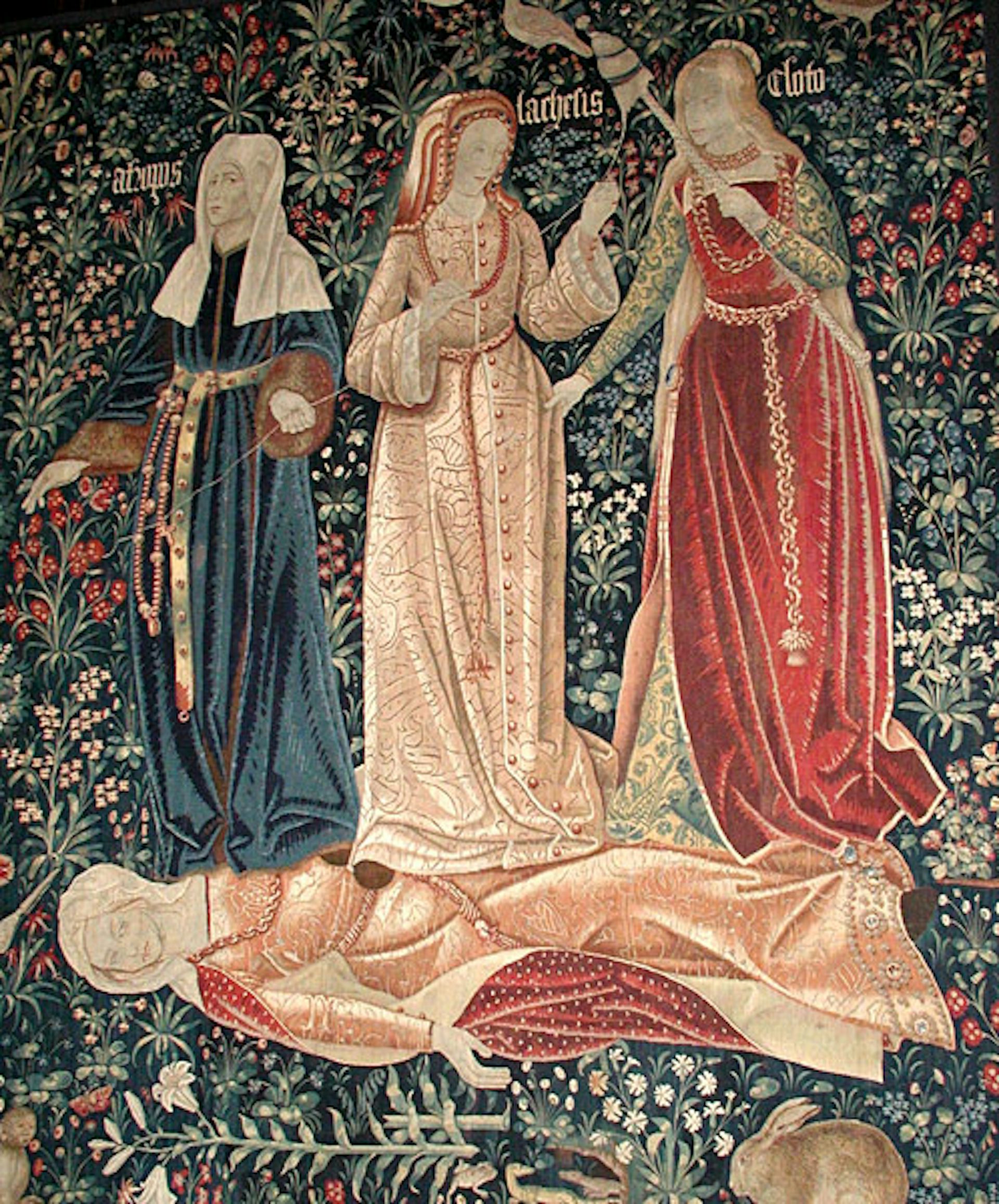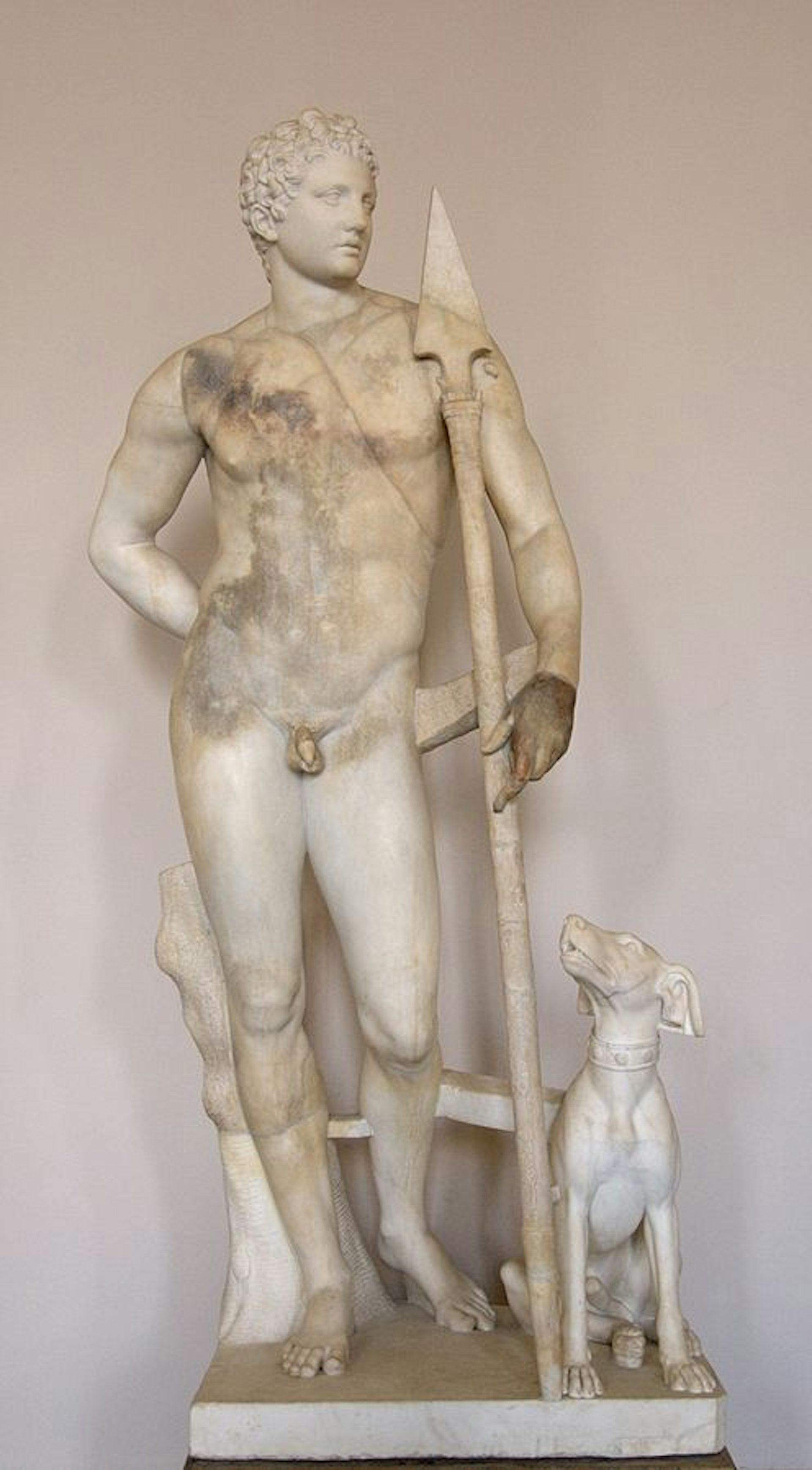Moirae (Fates)

The Three Fates by Alexander Rothaug (ca. 1910).
Jack Kilgore GalleryPublic DomainOverview
The Moirae, also known as the “Fates,” were the goddesses who personified the Greek concept of μοῖρα (moîra, “fate” or “allotment”). Their main function was to determine the lifespan of every mortal—when they would be born and when they would die. They were usually called the daughters of either Nyx (“Night”) or of Zeus and Themis.
The names of the three Moirae reflected their individual tasks: Clotho (“Spinner”) spun the thread of a mortal’s life, Lachesis (“Apportioner”) measured the thread to its allotted length, and Atropos (“Unbending”) cut the thread when the time for death had arrived.
The Moirae were treated with awe and dread in the ancient world; not even the gods could alter the course of their work. They were worshipped widely by the Greeks, often in connection with Underworld gods like the Erinyes (“Furies”), Persephone, or Hecate.
Etymology
The name “Moira” (Greek Μοῖρα, translit. Moîra) is also a Greek noun meaning “allotment” or “portion.”[1] Related Greek words include the noun μόρος (móros, “doom”) and the verb μείρομαι (meíromai, “receive a share, divide”). Etymologically, this group of words was likely derived from the Indo-European root *smer- (“remember, care”).[2]
In the common tradition, there were three Moirae, named Clotho (Κλωθώ, translit. Klōthṓ), Lachesis (Λάχεσις, translit. Láchesis), and Atropos (Ἄτροπος, translit. Átropos).[3] These names corresponded to the individual functions of the three Moirae with respect to the thread that represented a mortal’s life: Clotho, the “Spinner,” spun the thread; Lachesis, the “Apportioner,” measured the thread to its correct length; and Atropos, the “Unbending,” cut the thread when it had run its course.
Pronunciation
English
Greek
Moira, Moirae Μοῖρα (translit. Moîra), Μοῖραι (translit. Moîrai) Phonetic
IPA
[MOI-ruh, MOI-ri] /ˈmɔɪrə, ˈmɔɪriː/
Other Names
By Hesiod’s time, it was standard to speak of three Moirae: Clotho, Lachesis, and Atropos (see above). But the names and identities of the Moirae evolved and shifted over time. Even before Hesiod had first named the Moirae, Homer spoke of a personified goddess of fate, known as either Aisa (“Share”) or Moira (in this case, one goddess rather than three).[4] It seems that this is where the Moirae originated: indeed, goddesses such as Aisa and Moira were imagined from an early period as spinners of fate, a role eventually taken over by the Moirae.[5]
While some transformed the plural Moirae into a single Aisa or Moira, others pluralized them further: we thus sometimes encounter multiple Clothes[6] or Lacheseis.[7] On the famous François Vase, produced around 570 BCE, there were four Moirae rather than three.[8] Conversely, in Delphi, only two Moirae were recognized.[9] Finally, there is a hymn in which the Moirae are named as Aisa, Clotho, and Lachesis (rather than Atropos, Clotho, and Lachesis).[10]
In some traditions, the Moirae were variously connected or identified with other shadowy figures, including Ananke (“Necessity), Heimarmene (“Destiny” or “Due”), Ker (“Fatality”), Moros (“Doom”), Nemesis (“Retribution”), Pepromene (“Destiny” or “Finitude”), and Tyche (“Chance”), among others.
The Romans referred to the Moirae as the Fata (from which we derive the English term “Fates”) or, more frequently, as the Parcae. The individual Latin names of the three goddesses were Nona (the equivalent of the Greek Clotho), Decima (Lachesis), and Morta (Atropos).
Titles and Epithets
The Moirae had a range of epithets that highlighted their dreaded, fateful nature, such as ἀδρήστειαι (adrḗsteiai, “inescapable”), κραταιή (krataiḗ, “strong”), and ὀλοή or οὐλομένη (oloḗ, ouloménē, “destructive”). But the Moirae were sometimes called by appeasing epithets meant to neutralize or soften their infernal powers, including ἐπιφανεῖς (epiphaneîs, “radiant”) and σεμνή (semnḗ, “august”).
Attributes
Functions and Powers
The Moirae determined and guided the moira—literally the “portion” or “allotment”—that every mortal received when they were born. In the earliest sources, they appear to have been imagined more or less as personifications of the concept of fate. Thus, the figure of Moira (“Allotment”) was often indistinguishable from other figures like Aisa (“Share”) or Ker (“Doom”).
Eventually, the functions and powers of the Moirae were fleshed out in more detail. Hesiod wrote that there were three Moirae—Clotho, Lachesis, and Atropos—who respectively spun, measured, and cut the thread of a mortal’s life.
As the goddesses responsible for ensuring that every human life ran its allotted course, the Moirae were present at death but also at birth; their companions thus included Eileithyia, the goddess of childbirth,[11] and even Prometheus, with whom they were sometimes described as the creators of the human race.[12] As goddesses of fate, the Moirae naturally also knew the future and were sometimes regarded as prophetic or oracular figures.[13]

Roman sarcophagus showing Prometheus creating man as some of the gods stand by: from left to right, Athena (with her helmet), Hermes (with his winged cap and cloak), two Moirae (probably Lachesis and Clotho), Poseidon (with his trident), Artemis (with the moon crescent) and another Moira (presumably Atropos). From ca. 240 AD.
JastrowPublic DomainThe Moirae were ambiguous goddesses who “[gave] men at their birth both evil and good to have.”[14] They were usually associated with misfortune and death,[15] yet occasionally brought about favorable outcomes.[16] To make matters even more confusing, though the Moirae were worshipped with the chthonic gods of death and the Underworld, they were also counted among the heavenly Olympians.[17] Even the epithets of the Moirae—which were positive as often as they were negative—highlighted the goddesses’ dual nature (see above).
The Greeks’ conception of the Moirae continued to develop over time. Gradually, they came to signify not only the allotted span of a mortal’s life, but also the course of fate and the natural order of the cosmos more generally—forces to which mortals as well as immortals needed to submit.[18]
Other sources further specified that it was the Moirae who instructed the Erinyes (the “Furies”) on which mortals were to be punished for their crimes.[19] Eventually, the Moirae became identified with Heimarmene—a concept advanced by various philosophers, from the Presocratics to the Stoics, that morphed into a kind of universal fate or chain of causation.[20]
Finally, the Moirae existed in a complex relationship with the gods. Both the gods and the Moirae exercised a measure of control over the course of events and mortals’ fates, but their goals were not always in harmony. When the Moirae were understood in an “absolute” sense—that is, as the personification of fate itself—even the gods were powerless to resist them.[21] But as goddesses and objects of religious worship, the individual Moirae were, of course, subordinate to Zeus and the Olympians.
Characteristics, Symbols, and Iconography
Ancient representations of the Moirae differed widely. Many sources imagined them as wizened, hideous old hags; some even added that they were lame, moving in labored steps that mimicked the slow but sure advance of time towards its fated ends.[22]
Other sources, however, imagined the Moirae as regal figures, holding scepters or even wearing crowns and sitting on thrones.[23] This was how the Moirae were represented when they appeared (admittedly rarely) in ancient art.
Sometimes, individual Moirae were depicted with their own particular attributes or symbols: Clotho with a spindle or the book of fate, Lachesis with a measuring instrument, and Atropos with a cutting instrument. Artists also included the Moirae as a triad in many mythical scenes, including the Gigantomachy and the births and marriages of various gods.[24]

The Triumph of Death, or The Three Fates. Flemish tapestry (probably from Brussels, ca. 1510–1520). Victoria and Albert Museum, London.
PriorymanPublic DomainFamily
Family Tree
Mythology
Meleager
In one story, the Moirae visited Althaea, the queen of Calydon, soon after she had given birth to her son Meleager (usually, this was on the seventh day after his birth). Pointing to a log that was burning in the fireplace, the Moirae warned Althaea that Meleager’s fate was tied to that log: he would die as soon as it was consumed by the fire. Althaea immediately removed the log and hid it—only to throw it back into the fire years later, after finding out that Meleager had killed her brothers.[33]

Statue of Meleager, Roman copy of a 4th-century BCE Greek bronze original attributed to Scopas. Pergamon Museum, Berlin, Germany.
Wikimedia CommonsPublic DomainHeracles
The Moirae also featured in some versions of the birth of Heracles. As the story goes, the goddess Hera was jealous of her husband Zeus’ affair with the mortal Alcmene; she therefore did everything in her power to prevent their child Heracles from being born.
In most traditions, Hera sent her daughter Eileithyia, the goddess of childbirth, to lengthen Alcmene’s labor. But in one tradition, recorded by Antoninus Liberalis, Hera sent the Moirae to help Eileithyia (with whom they were often associated in antiquity). Together, Eileithyia and the Moirae managed to delay the birth of Heracles until they were deceived by one of Alcmene’s handmaids (whom they promptly transformed into a weasel for her troubles).[34]
The Gigantomachy
When Gaia sent the Giants (her children) to attack the Olympian gods, the Moirae bravely participated in the battle against them (the so-called Gigantomachy). Wielding bronze maces, they killed the Giants Agrius and Thoas.[35]
Typhoeus
According to Apollodorus, the Moirae also helped Zeus in his battle with Typhoeus, another one of Gaia’s monstrous children. During their battle, Zeus chased Typhoeus to Nysa. There, the Moirae tricked the creature into eating a magical fruit that they promised would strengthen him. In reality, this “ephemeral” fruit greatly weakened Typhoeus, and Zeus defeated him soon after.[36]
Other Myths
The Moirae frequently appeared in ancient literature, art, and inscriptions. Consequently, they occasionally played a role in other myths.
For example, the poet Pindar wrote that it was Clotho, one of the Moirae, who restored Pelops to life after he had been killed under mysterious circumstances.[37]
Aeschylus, writing around the same time as Pindar, connected the Moirae with the myth of Alcestis: according to Aeschylus, Apollo got the Moirae drunk so that they would agree to let his friend, the mortal Admetus, escape his death if he could find a willing substitute to take his place.[38]
Worship
Temples
The Moirae had temples in many Greek cities, some of which reflected the darker, infernal aspects of their cult. In Sparta, for example, their sanctuary was located near the tomb of the hero Orestes.[42] And in Sicyon, the Moirae had an altar in the grove of the Erinyes.[43]
The Moirae are also known to have had sanctuaries at Corinth,[44] Olympia,[45] and Thebes,[46] to name just a few sites.
Identifications and Associations
In cult, the Moirae were often closely associated with Zeus—more specifically, with Zeus as Zeus Moiragetes, “Guide of the Moirae.”[47] In this guise, Zeus ruled over the Moirae and instructed them on the proper course of fate. The development of this cultic relationship may have inspired the mythical genealogy in which Zeus was called the father of the Moirae (see above).
Since they were thought to be present at various pivotal stages in a human’s life—birth, marriage, death, and so on—the Moirae were also associated with other gods who presided over each of these stages, including Eileithyia,[48] goddess of childbirth, and the wedding goddesses Artemis[49] and Aphrodite.[50]
In Athens especially (but also other parts of Greece), the Moirae were associated with the Erinyes, who were worshipped there under the euphemism “Eumenides” (“Well-Meaning Ones”).[51] In other places, the Moirae were associated with the Horae and the Graces.[52]
Pop Culture
The Moirae continue to make appearances in modern pop culture, where they are most commonly known as the “Fates.”
In literature, the Moirae have featured in Rick Riordan’s Percy Jackson and the Olympians series (2005–2009), Neil Gaiman’s graphic novel series The Sandman (1989–), and Stephen King’s novel Insomnia (1994).
In visual culture, the Moirae have appeared in TV shows such as Xena: Warrior Princess and Sabrina the Teenage Witch, as well as the 1997 Disney film Hercules. They also feature in the video game God of War 2.